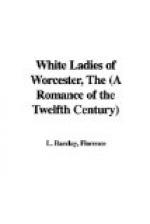“Who art thou, and what doest thou here?”
The figure answered not.
“Art thou a ghostly visitor come back amongst us, from the Realm of the Unseen?”
The figure made no sign. “Art thou then flesh and blood, and mortal as ourselves?”
Slowly the figure bowed its head.
“Now I adjure thee by our blessed Lady to tell me truly. Art thou, in very deed a holy nun, a member of our sacred Order? Answer me, yea or nay?”
The figure shook its head.
The Prioress advanced a step, passed the key into her left hand and, slipping her right beneath her scapulary, took firm grip of the dagger at her girdle.
“Then, masquerader in our sacred dress,” she said, “to me you have to answer for double sacrilege: the wearing of these robes, and your presence here, unbidden. I warn you that your life has never hung by frailer thread than now it hangs. Your only hope of safety lies in doing as I bid you. Pass before me along this passage until you reach a chamber on the right, of which the door stands open. Enter, and place yourself against the wall on the side farthest from the door. There I will speak with you.”
With the shuffling steps of a woman, and the bent shoulders of the very old, the figure moved slowly forward, stepped upon the front of the white robe, stumbled, but recovered.
The Prioress watching, laughed—a short scornful laugh, holding more of anger than of merriment.
With an abrupt movement the figure straightened, stood at its full height, and strode forward. The Prioress marked the squaring of the broad shoulders; the height, greater than her own, though she was more than common tall; the stride, beneath the folds of the long robe; and she knit her level brows, for well she knew with whom she had to deal. She was called to face a desperate danger. Single-handed, she had to meet a subtle foe. She asked no help from others, but she took no needless risks.
As she passed the cell of Mary Seraphine, using her master-key, she locked that lady in!
CHAPTER X
“I KNOW YOU FOR A MAN”
Entering her cell, the Prioress saw at once that her orders had been obeyed.
The hooded figure stood on the far side of the chamber, leaning broad shoulders against the wall. Under the cape, the arms were folded; she could see that the feet were crossed beneath the robe. The dress was indeed the dress of a White Lady, but the form within it was so obviously that of a man—a big man, at bay, and inclined to be defiant—that, despite the strange situation, despite her anger, and her fears, the contrast between the holy habit and its hidden wearer, forced from the Prioress an unwilling smile.
Closing the door, she drew forward a chair of dark Spanish wood, the gift of the Lord Bishop; a chair which well betokened the dignity of her high office.




